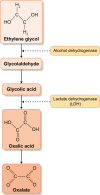Oxalate nephropathy: a review
- PMID: 35145635
- PMCID: PMC8825217
- DOI: 10.1093/ckj/sfab145
Oxalate nephropathy: a review
Abstract
This review describes the clinical and pathological features of oxalate nephropathy (ON), defined as a syndrome of decreased renal function associated with deposition of calcium oxalate crystals in kidney tubules. We review the different causes of hyperoxaluria, including primary hyperoxaluria, enteric hyperoxaluria and ingestion-related hyperoxaluria. Recent case series of biopsy-proven ON are reviewed in detail, as well as the implications of these series. The possibility of antibiotic use predisposing to ON is discussed. Therapies for hyperoxaluria and ON are reviewed with an emphasis on newer treatments available and in development. Promising research avenues to explore in this area are discussed.
Keywords: acute kidney injury; oxalate nephropathy; pathology; primary hyperoxaluria; secondary hyperoxaluria.
© The Author(s) 2021. Published by Oxford University Press on behalf of the ERA.
Figures





References
-
- Yang Y, Sharma PD, Nair V et al. Kidney oxalate crystal deposition in adult patients: a relatively common finding. Clin Nephrol 2020; 93: 243–250 - PubMed
LinkOut - more resources
Full Text Sources
Miscellaneous

